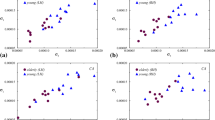Abstract
This study examined age differences in the factor structure of EEG using a 128-electrode system. Running EEG records were obtained from healthy younger and healthy older adults before, during, and after they performed a 13-minute Continuous Performance Task. Factor analyses were conducted on each five-second segment of EEG data by treating the voltages obtained at each electrode site as variables and each measurement epoch as a case. Results showed that the EEG records of older adults yielded significantly more factors than those of younger adults in every task condition. In addition, eigenvalues for the first common factor derived from EEG data sets were significantly larger in the EEG recordings of younger adults than older adults. The results are interpreted to indicate a greater degree of complexity in the spatial distribution of EEG activity in older adults, possibly reflecting an age-related decrease in the degree of coordination among cortical areas.
Similar content being viewed by others
References
Anohkin, A.P., Birbaumer, N., Lutzenberger, Nokolaev, A. and Vogel, F. Age increases brain complexity. Electroencephalography and Clinical Neurophysiology, 1996, 99: 63–68.
Arruda, J.E., Weiler, M.D., Valentino, D., Willis, W.G., Rossi, J.S., Stern, R.A., Gold, S.M. and Costa, L. Aguide for applying principal-components analysis and confirmatory factor analysis to quantitative electroencephalographic data. International Journal of Psychophysiology, 1996, 23: 63–81.
Double, K.L., Halliday, G.M., Kril, J.J., Harasty, J.A., Cullen, K., Brooks, W.S., Creasy, H. and Broe, G.A. Topography of brain atrophy during normal aging and Alzheimers disease. Neurobiology of Aging, 1996, 17: 513–521.
Duffy, F.H., Albert, M.S., McAnulty, G. and Garvey, A.J. Age-related differences in brain electrical activity of healthy subjects. Annals of Neurology, 1984, 16: 430–438.
Freeman, W.J. and Grajski, K.A. Relation of olfactory EEG to behavior: Factor analysis. Behavioral Neuroscience, 1987, 101: 766–777.
Guttman, C.R., Jolesz, F.A., Kikinis, R., Killany, R.J., Moss, M.B., Sandor, T. and Albert, M.S. White matter changes with normal aging. Neurology, 1998, 50: 972–978.
Hartikainen, P., Soininen, H., Helala, E.L. and Riekkinen, P. Aging and spectral analysis of EEG in normal subjects: A link to memory and CSF AChE. Acta Neurologica Scandinavia, 1992, 86: 148–155.
Janowsky, J.S., Kaye, J.A. and Carper, R.A. Atrophy of the corpus callosum in Alzheimers disease versus healthy aging. Journal of the American Geriatric Society, 1996, 44: 798–803.
Jeeves, M.A. and Moes, P. Interhemispheric transfer time differences related to aging and gender. Neuropsychologia, 1996, 34: 627–636.
Klass, D.W. and Brenner, R.P. Encephalography of the elderly. Journal of Clinical Neurophysiology, 1995, 12: 116–131.
Kolmogorov, A.N. Three approaches to the definition of the concept of the quantity of information. IEEE Trans. Infor. Theory, IT14, 1965, 14: 662–669.
Marciani, M.G., Mashio, M., Spanedda, F., Caltagirone, C., Gigli, G.L. and Bernardi, G. Quantitative EEG evaluation in normal elderly subjects during mental processes: Age-related changes. International Journal of Neuroscience, 1994, 76: 131–140.
Pierce, T.W., Kelly, S.K., Watson, T.W., Replogle, D., King, J.S. and Pribram, K.H. Age differences in dynamic measures of EEG. Brain Topography, 2000, 13: 127–134.
Sanford, J.A. Intermediate Visual and Auditory Continuous Performance Test: Interpretation. Manual Version 1.2. Braintrain: Richmond, VA., 1995.
Tucker, D.M. Spatial sampling of head electrical fields: The geodesic sensor net. Electroencephalography and Clinical Neurophysiology, 1993, 87: 154–163.
Tucker, D.M. and Roth, D.L. Factoring the coherence matrix: Patterning of the frequency-specific covariance in a multichannel EEG. Psychophysiology, 1984, 21: 228–236.
Whiting, W.L., Madden, D.J., Langley, L.K., Denny, L.L., Turkington, T.G., Provenzale, J.M., Hawk, T.C. and Coleman, R.E. Lexical and sublexical components of age-related changes in neural activation during visual word identification. Journal of Cognitive Neuroscience, 2003, 15: 475–487.
Winterer, G., Mulert, C., Mientus, S., Gallinat, J., Schlattmann, P., Dorn, H. and Herrmann, W.M. P300 and LORETTA: Comparison of normal subjects and schizophrenic patients. Brain Topography, 2001, 13: 299–313.
Author information
Authors and Affiliations
Rights and permissions
About this article
Cite this article
Pierce, T.W., Watson, T.D., King, J.S. et al. Age Differences in Factor Analysis of EEG. Brain Topogr 16, 19–27 (2003). https://doi.org/10.1023/A:1025654331788
Issue Date:
DOI: https://doi.org/10.1023/A:1025654331788




